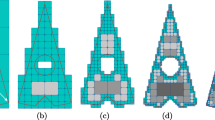Abstract
This paper presents a scheme for decomposing polyhedra called multi-LREP. The scheme is based on the L-REP decomposition, which classifies the triangular faces of a polyhedron into a set of layered tetrahedra. In the multi-LREP these layered tetrahedra are grouped into regions of a space subdivision. The paper also describes an efficient method for constructing the L-REP decomposition and how the multi-LREP can be applied to speed up two L-REP applications: the point-in-polyhedron inclusion test and the ray-scene intersection. An experimental comparison with other point-in-polyhedron tests is presented as well.
Similar content being viewed by others
Explore related subjects
Discover the latest articles, news and stories from top researchers in related subjects.References
Akenine, M., Haines, E.: Real-time Rendering, 2nd edn. A.K. Peters, Natick (2002), p. 835
de Berg, M., van Kreveld, M., Overmars, M., Schwarzkopt, O.: Computational Geometry: Algorithms and Applications, 2nd edn. Springer, Berlin (2000), p. 367
Bergen, G.: Efficient collision detection of complex deformable models using AABB tress. J. Graph. Tools 2(4), 1–13 (1997)
Feito, F.R., Torres, J.C.: Inclusion test for general polyhedra. Comput. Graph. 21(1), 23–30 (1997)
Glassner, A.S.: Space subdivision for fast ray tracing. IEEE Comput. Graph. Appl. 4(10), 15–22 (1984)
Haines, E.: Point in polygon strategies. In: Heckbert, P. (ed.) Graphics Gems IV, pp. 24–45. Academic Press, San Diego (1994)
Martínez, F., Rueda, A.J., Feito, F.R.: The multi-L-REP decomposition and its application to a point-in-polygon inclusion test. Comput. Graph. 30(6), 947–958 (2006)
Ogayar, C.J., Segura, R.J., Feito, F.R.: Point in solid strategies. Comput. Graph. 29(4), 616–624 (2005)
Rueda, A.J., Feito, F.R., Ortega, L.M.: Layer-based decomposition of solids and its applications. Vis. Comput. 21(6), 406–417 (2005)
Rueda, A.J., Feito, F.R., Rivero, M.L.: A triangle-based representation for polygons and its applications. Comput. Graph. 26(5), 805–814 (2002)
Samet, H.: Foundations of Multidimensional and Metric Data Structures. Morgan Kaufmann, San Mateo (2006), p. 993
Wang, W., Li, J., Sun, H., Wu, E.: Layer-based representation of polyhedrons for point containment test. IEEE Trans. Vis. Comput. Graph. 14(1), 73–83 (2008)
Author information
Authors and Affiliations
Corresponding author
Rights and permissions
About this article
Cite this article
Martínez, F., Rueda, A.J. & Feito, F.R. The multi-LREP decomposition of solids and its application to a point-in-polyhedron inclusion test. Vis Comput 26, 1361–1368 (2010). https://doi.org/10.1007/s00371-009-0413-6
Published:
Issue Date:
DOI: https://doi.org/10.1007/s00371-009-0413-6




